Born: 28 November 1864 — Hangmei, Zhongshan (Heung Shan or Chung San, Guangdong, China.
Married: Agnes Yaupaung 28 April 1892 at the Wesleyan Methodist Church, Tingha. N.S.W. Australia
Died: 26 January 1939 — Canterbury, New South Wales, buried in Rookwood Cemetery
This simplified family tree shows some of the key individuals, highlighted in red are the family members that are Chinese-born.

Lee Kee Chong 李 基 祥 born in 1864 in Heung Shan, just south of the Pearl River Delta in Guangdong province, Southern China.
While not a lot is known about Lee in China, we know that life in Heung Shan would have been a struggle. There was a period of turmoil immediately after the recent 2nd Opium war and the consequences of the Civil Wars, dealing with corruption, high taxes, inflation, opium addiction, lawlessness, bandits, rapid population growth, record-breaking–droughts, floods, and famine.
And on top of all this, there may have been added pressure from within the family to leave China in search of employment opportunities and enrichment.
According to Beth Woo’s family research, in 1880 my great-great-grandfather Lee Kee Chong left Hong Kong aged 16, onboard the Brisbane of The Eastern and Australian Steam Mail Company. During 1880 thousands of Chinese sojourners arrived in Australia, before the introduction of the ‘Influx of Chinese Restriction Act’ of 1881, which aimed at drastically reducing, if not halting, the numbers of Chinese immigrating to Australia.
Arriving a generation after my other ancestors, Lee’s prospects would have been different. He was an educated man and was possibly sponsored by a family member or storekeeper from his home district. Lee lived and worked near the Haymarket-end of Sydney (now known as Chinatown) from 1880 to 84. He would have been provided with an employment and accommodation package.
To supplement his income Lee wrote letters on behalf of his fellow countrymen, and also acted as an interpreter for Chinese attending court as well as their interaction with local law enforcement.
By 1885, after Lee completed his contract in Sydney, he had accumulated enough wealth to venture-out on his own. Sydney at the time was not that attractive a prospect to a young Chinese immigrant – due to an upsurge of violence against Chinese traders as a consequence of the perceived threat of being swamped by Chinese immigrants.
Lee soon headed to the mining town of Tingha. Chinese migrants were attracted to Tingha by climbing tin prices. He probably started working in one of the general stores which quickly sprang up to support the needs of the rapidly growing white and Chinese mining community.
Lee Kee Chong & Agnes Yaupaung
While working in a store in Tingha, Lee met Agnes Yaupaung – my great-great–grandmother. Agnes was working in a local Café at the time. A family anecdote relates that she asked her friend (and employer) as to whether she should marry this young man. She was advised to do so, because then she would be ‘safe’. They married in 1892 at the Wesleyan Church Tingha.
By 1894 tin-mining began to wane due to a drought, which affected the ability to dredge. Seeking new opportunities Lee set his sights on Moree. That town boasted a completed rail link to nearby Narrabri, an established Bank and School. Two years into their marriage they relocated.
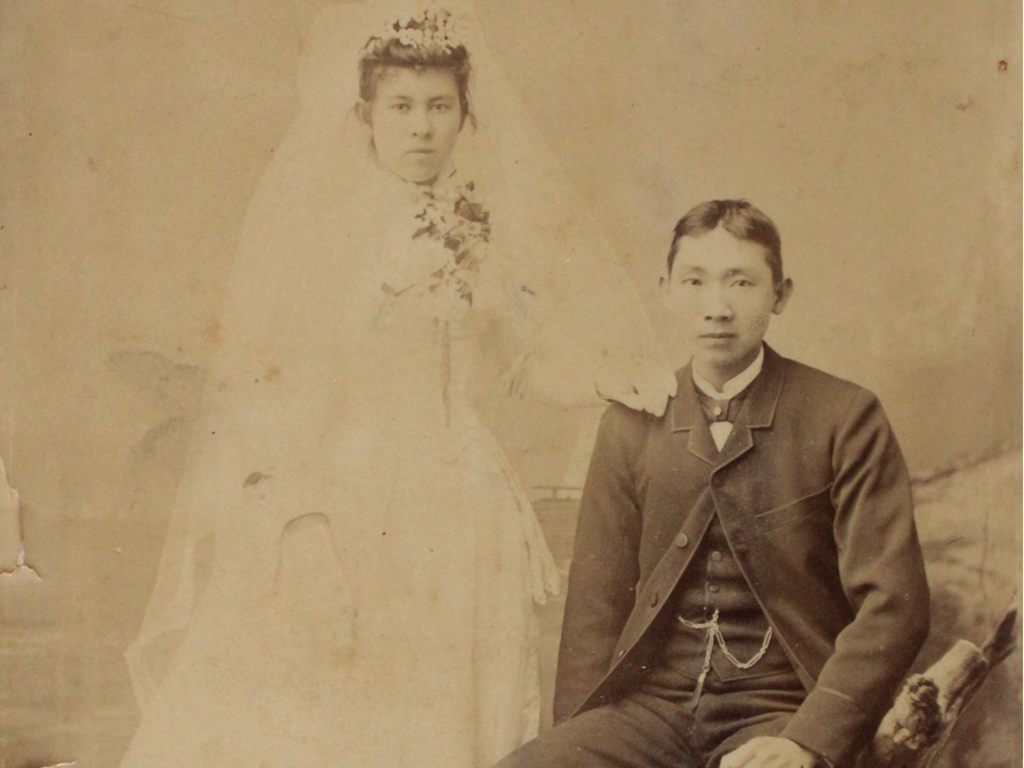
By 1901 Lee started what became a successful General Store SAM LEE & CO with two business partners – Gee Ick and Den War. They regularly advertised their wares in the Moree Gwydir Examiner, advertising as — cash buyers of —skins, hides, wool, horsehair, and marsupial skins. Later adverts include drapery, grocery, boots, and shoes.
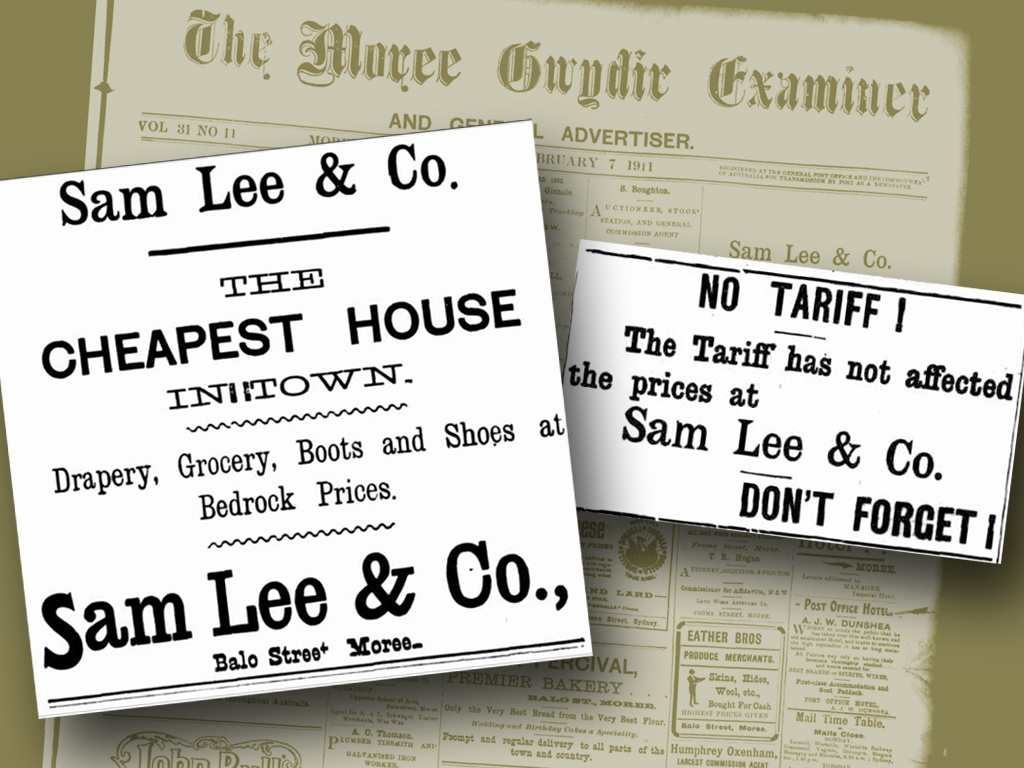

Lee and Agnes soon started a family with the birth of their first child, my Great-grandmother Esther Grace, who was born in 1895. This photo is of Agnes and her newborn son George.
Children of Lee Kee Chong and Agnes Yaupaung
- Daughter Ester Grace KEE CHONG (1895–1985) Born 22 May 1895 Moree NSW Australia
- Daughter Norah Kee-Chong (1896–1988) Born 1896 Moree, New South Wales, Australia
- Son George Kee-Chong (1898–1980) Born 1898 Moree NSW Australia
- Son Athol Kee-Chong (1901–1901), Moree NSW Australia
- Son Edward Lee Kee-Chong (1903–1980) Borne 1903 Moree NSW Australia
- Daughter Bessie Kee-Chong (1908–2002) 20/02/1908 Moree NSW Australia
- Daughter Madge Kee-Chong( 1910–1986) 1910 Moree NSW Australia
- Twin — Daughter Mercia Hope Kee Chong(1913–1981) 26 Jul 1913, Moree NSW Australia
- Twin — Son Maurice Kee-Chong (1913–2004) 26 Jul 1913, Moree NSW Australia
Lee Family Visit China, 1903
To celebrate Lee’s business success and show-off his new family, they embarked on a journey to Heung Shan in Southern China on 29th December 1903. Accompanying Lee on the journey were his wife Agnes and their four children Grace (aged 8), Norah (7), George (5) and Edward, their newborn son.
While in China the children would have become quite fluent in the local Chinese dialect – Cantonese and most likely stayed in Lee’s home village in Heung Shan.
Lee takes a second wife
While Lee was in China, he took a second wife. This understandably caused quite a bit of friction with Agnes – and Grace. Over the years Lee made several trips back to China visiting his ‘other’ family and according to Trevor my grandpa
“spent quite a bit of money over there supporting them.”
Trevor recounted an anecdote that he remembers being told by his mother Grace that … “the eldest son was kidnapped, by bandits. [Who] Came to the village thinking, or knowing possibly that any of the Chinese that came back home from Australia must be reasonably wealthy and of course he had to pay ransom. They kept him caged up for a few days and of course when his father paid the ransom, they got him back all right.”
Immigration Restriction Act of 1901
Traveling to and from China after the newly introduced Immigration Restriction Act of 1901 referred to as the White Australia Policy, presented a raft of complex issues for Lee and his family. The new restrictions prohibited re-entry into Australia unless they could pass a dictation literary test. Initially, the test could be in any designated European language. In 1905 the bar was raised to make it more difficult and the dictation test could be in any language!
The only way to obtain an exemption from the dictation test was to provide documentation proving Australian domicile from an earlier period, or proven naturalisation. To circumvent these restrictions in Lee’s case he applied for Certificates of Domicile and Certificates of Exemption for the family.
Although the Immigration rules were prohibitively restrictive at the time, it has today inadvertently provided a treasure trove of documentary evidence relating to Chinese travels. The complicated official process of documentation and meticulous recording provides us with descriptions of their physical appearance accompanied by criminal-type mug-shot photographs and handprints, personal details, employment details and the number of years spent living in different towns.
Lee family return to Australia 1905
Lee Kee Chong returned to Australia 1905 disembarking in Brisbane, while his wife Agnes and the 4 children remained in China till 1906, returning aboard the “Empire”. Traveling with them on the return trip were Agnes’ sister Emily and her husband Sam Kee and their three children.
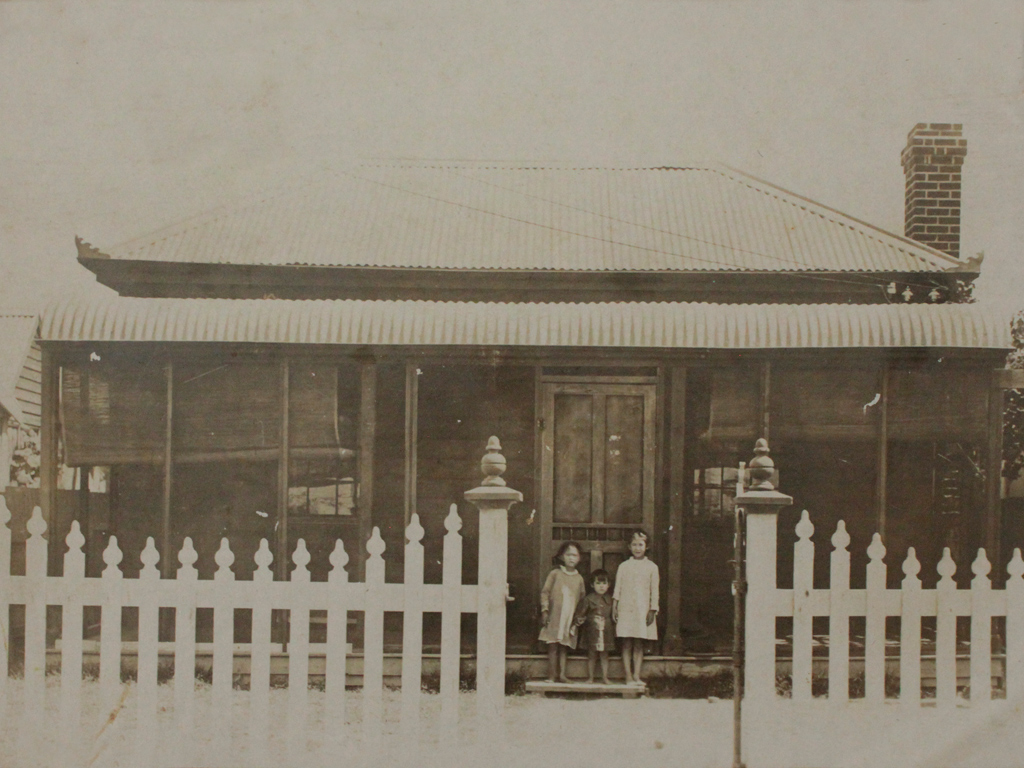
Application for Certificate of Naturalisation and citizenship – Australia
By 1911 Lee had been living and working in Australia for more than 30 years, he was married with seven children. On applying for a Certificate of Naturalisation he was rejected – on the grounds of being a Chinese subject! To add insult to injury his wife Agnes, on marrying Lee was recorded as “Australian born, but lost nationality through marriage with Chinese” and is declared an alien.
Then in 1940, now recently widowed, Agnes successfully applied for and had her British citizenship reinstated on the basis of no longer being married to a Chinese man. The stigma of her questionable nationality required that in 1944 she had to report to Police to obtain a statement from them to prove this.


Return to Hay street China Town, Sydney 1919
By 1919 Lee and his family relocated back to Sydney and he becomes a partner in the prominently situated Hop Chong Company in Chinatown. On Trove, there are also numerous advertisements of his business the Hop Chong Company proclaiming they are: “Importers and Exporters” and “Fruit and Produce Merchants and General Commission Agents” at 100 Hay Street, Sydney.
During his lifetime the now relatively affluent Lee became a philanthropist. To perpetuate his family name back in his home village in China he petitioned fellow Lee-clan members to raise funds towards the cost of furniture and couplet inscriptions for a Lee-family ancestral hall in Hang Mei.
Lee Kee Chong died in 1939. Although he had made his fortune, his Australian children seemingly never forgave his establishing a second Chinese-based family, and they had become estranged from him.

GRAVE OF MR. LEE KEE CHONG OF HANG MEI, LEUNG TO.
DIED 26TH JANUARY IN THE YEAR ONE-THOUSAND-NINE-HUNDRED-AND-THIRTY-NINE.
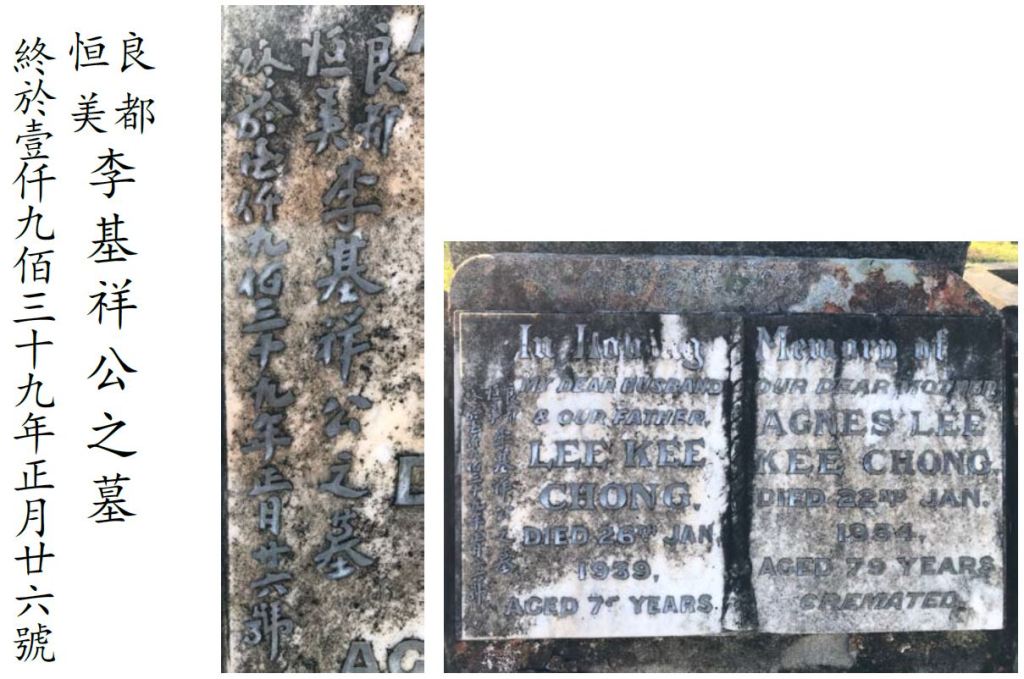
In May 2019, I visited Rookwood cemetery and located Lee’s grave. I was thrilled to discover Chinese characters on the headstone and I knew that with this information I could access his full Chinese name and place of birth –Hang Mei, Leung To, Heung Shan (Zhongshan). With the help of Douglas Lam and Ely Finch I had the text transcribed which substantially filled-out and added to his life’s story.
Tombstone Translation and notes by Ely Finch
- The font used in the inscription is that of running writing, in a somewhat blocky style, which is typical of the 1930s.
- The Chinese character at bottom left is given in a variant form, which is not available in electronic character sets. The standard
traditional character is accordingly given in the transcription. - 良都“Leung To” or “Leung Subdistrict” was one of the first tier of administrative blocks into which the district of 香⼭Heung
Shan, which became the district of 中⼭Chung Shan—or Zhōngshān in Mandarin—in 1925, was formerly divided. It was
located to the immediate south of the district’s commercial and administrative centre of ⽯岐Shekki. (Note that the spelling
“Leung To” reflects the standard Cantonese pronunciation; the Mandarin equivalent is Liángdū.) - See the map of Chung Shan below (taken from page 69 of Dr Michael Williams’s Returning Home with Glory: Chinese Villagers
around the Pacific, 1849 to 1949), on which Leung To is clearly delineated and labelled “Liang Du”. - 恆美Hang Mei is the name of a village, which was located in Leung To, and fell within a Cantonese-speaking region of
linguistically diverse Chung Shan. It is marked “20” in the second map appended below, which is taken from page 71 of the
aforementioned reference. (Note that the Mandarin Pinyin romanisation of Hang Mei is Héngměi.) - 李Lee is the deceased’s surname and translates literally as “plum” (meaning the tree or the fruit, as in English).
- 基祥Kee Chong is the deceased’s given name. This romanisation reflects the name’s pronunciation in the Heung
Shan/Zhongshan (A.K.A. Macao) dialect of Cantonese. In standard Cantonese, the pronunciation might be represented as “Kei
Cheung”. In both cases the K is pronounced like an initial G in English. (Initial and final Gs in English, such as those in the
words “gag” and “gig”, are different sounds: linguists preferred and still prefer to write the first as a K.)
Additional research on Trove and links, by Ely Finch
A search of Trove made using the deceased’s Chinese name, reveals a fair number of articles in Sydney’s old Chinese-language
newspapers that concern him, and may contain additional information of interest. The following is a selection, each accompanied
by a summary of content:
- 4th May 1912, The Chinese Australian Herald: https://trove.nla.gov.au/newspaper/article/168800621
(£2 subscription made by Lee Kee Chong, via the Yee Hing Society, for bonds being issued by a new Chinese republican
government in urgent need of funds. The number of Chinese Australian subscribers was extensive.) - 29th November 1919, The Chinese Australian Herald: https://trove.nla.gov.au/newspaper/article/168565572
(An article concerning the establishment of a shop, named 合昌公司the Hop Chong Company, by Lee Kee Chong and business
partner 李寶成“Lee Po Shing”, on Sydney’s “Haymarket Street”. The article describes the men as experienced and reputable
merchants who are conscientious in their dealings.) - 3rd July 1920, The Chinese Republic News: https://trove.nla.gov.au/newspaper/article/225205690
(Notice, posted by Lee Kee Chong of the Hop Chong Company and another man, of the The Chinese Republic News, which is
addressed to all their fellow Lees of Hang Mei residing in rural New South Wales, and calls on them to join those in Sydney in
raising a sum of £400–£500 towards furniture and couplet inscriptions for a Lee-family ancestral hall in Hang Mei, the renovation
of which is nearing completion and has been funded through the generosity of their fellows in Hawaii and Victoria—i.e. the
capital of British Columbia, Canada. Subscribers are requested to write to either one of them, care of the Hop Chong Company or
The Chinese Republic News respectively. They are identified in the notice as the initiators of the appeal.) - 10th December 1921, The Chinese Republic News: https://trove.nla.gov.au/newspaper/article/225205136
- 17th December 1921, The Chinese Australian Herald: https://trove.nla.gov.au/newspaper/article/168569966
(Bond subscriptions.) - 1922–1923, The Chinese Republic News:
https://trove.nla.gov.au/newspaper/article/225211773
https://trove.nla.gov.au/newspaper/article/225207781
https://trove.nla.gov.au/newspaper/page/24088121
https://trove.nla.gov.au/newspaper/page/24087927 (clearest image)
(An advertisement for the Hop Chong Company, “Importers and Exporters” and “Fruit and Produce Merchants and General
Commission Agents”, of 100 Hay Street, Sydney, which address is given in English as being the corner of Hay and Dixon Streets.
The building in question, which is pictured in the advertisement, still stands: it is Sydney Chinatown’s well-known Emperor’s
Restaurant.) - 21st May 1932, The Chinese Republic News: https://trove.nla.gov.au/newspaper/article/226546460
(£2 donation towards an appeal in support of China and its resistance of Japan, after the latter’s annexation of Manchuria.) - There are many other articles in Australia’s old Chinese-language newspapers that concern the village of Hang Mei. One from
January 1907 (https://trove.nla.gov.au/newspaper/article/246924482) relates that, unlike the neighbouring Kwok-family village of
⽵秀園 Chuk Sau Yuen and Ma-family village of 沙涌Sha Chung, the Lee-family village of Hang Mei lacks a school; it goes
on to encourage the several hundred Lees of Hang Mei in Australia to follow the example set by the Kwoks and Mas by raising
funds to establish one. One from November 1921 (https://trove.nla.gov.au/newspaper/article/225202456) relates that 500–600 of
the Lees of Hang Mei, which it says has several thousand inhabitants, are presently in Canada and Australia, making them Chung
Shan’s largest overseas grouping from one family and one village; it goes on to encourage the donation of funds towards the
establishment of a monthly newspaper in the village.
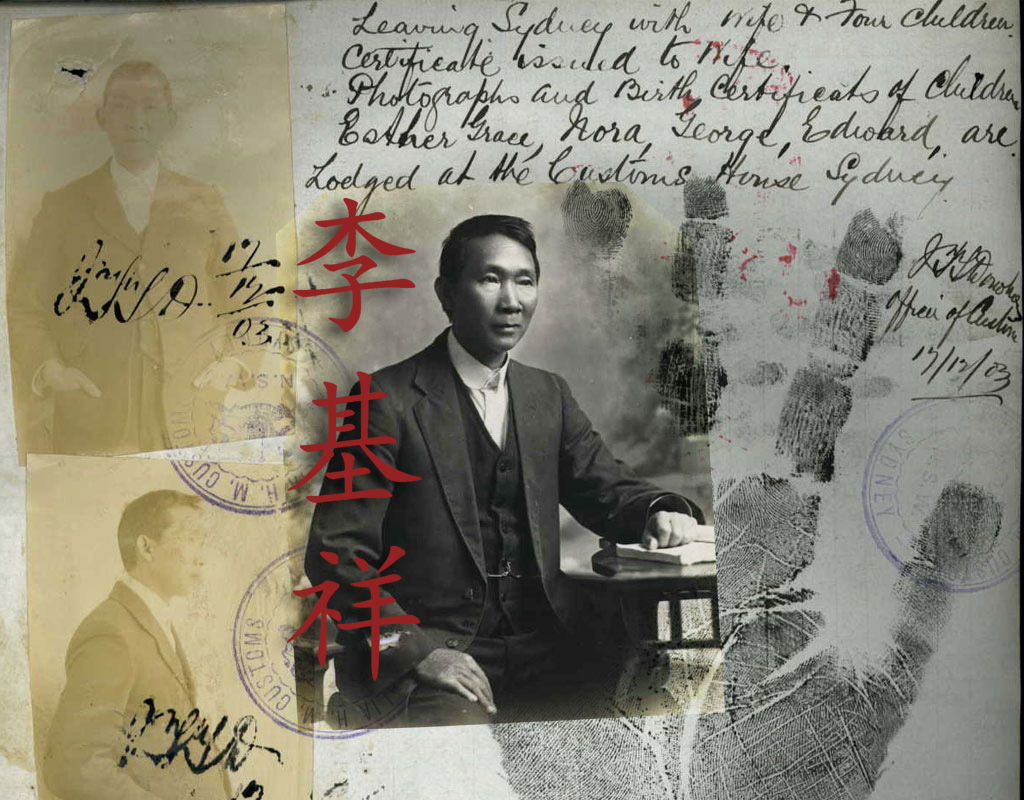

















Leave a comment